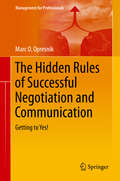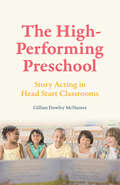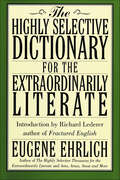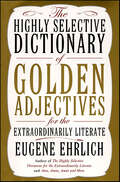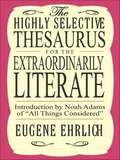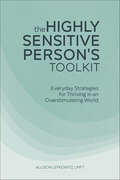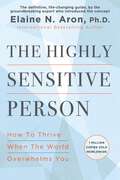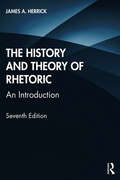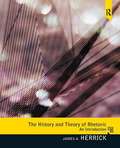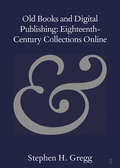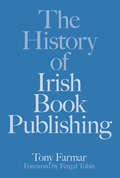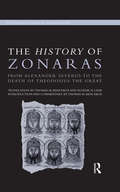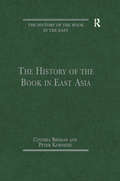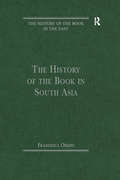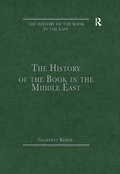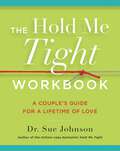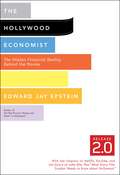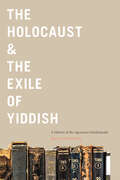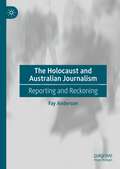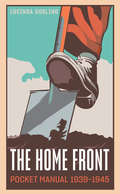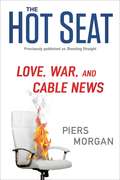- Table View
- List View
The Hidden Rules of Successful Negotiation and Communication
by Marc O. OpresnikNegotiations in professional or private life often take an unsatisfactory course due to stress, confrontation with aggressive or unfair behavior, or because of overwhelming situations. Negotiations generally require a thorough preparation, strategy and a sophisticated tactic to make us feel safe in the presentation of our goals and arrive at a mutually satisfactory outcome. Conventional books about negotiations are usually limited to strategies and techniques, but leave out elements of psychological communication and emotional intelligence, which include non-verbal communication and empathy, which in turn are essential for successful negotiation. Therefore, this book on the one hand constitutes the essential techniques and strategies in the context of negotiation, but also considers "soft skills" without which negotiations cannot be successful. This book presents practical examples in dealing with situations such as salary, contract and sales negotiations. In particular on context and time appropriate negotiation techniques; analyzing negotiation partners and their motives; interpret group processes, and how to successfully implement negotiation psychology.
The High-Performing Preschool: Story Acting in Head Start Classrooms
by Gillian Dowley McnameeThe High-Performing Preschool takes readers into the lives of three- and four-year-old Head Start students during their first year of school and focuses on the centerpiece of their school day: story acting. In this activity, students act out stories from high-quality children’s literature as well as stories dictated by their peers. Drawing on a unique pair of thinkers--Russian psychologist Lev Vygotsky and renowned American teacher and educational writer Vivian G. Paley--Gillian Dowley McNamee elucidates the ways, and reasons, this activity is so successful. She shows how story acting offers a larger blueprint for curricula that helps ensure all preschools--not just those for society’s well-to-do--are excellent. McNamee outlines how story acting cultivates children’s oral and written language skills. She shows how it creates a crucial opportunity for teachers to guide children inside the interior logic and premises of an idea, and how it fosters the creation of a literary community. Starting with Vygotsky and Paley, McNamee paints a detailed portrait of high-quality preschool teaching, showing how educators can deliver on the promise of Head Start and provide a setting for all young children to become articulate, thoughtful, and literate learners.
The Highly Selective Dictionary for the Extraordinarily Literate (Highly Selective Reference)
by Eugene EhrlichBetween TV talk shows, radio call-in programs, email and the Internet, spontaneous-talk media has skyrocketed in the '90s. People are interacting more frequently and more fervently than ever before, turning the English language into an indecipherable mess. Now, this unique and concise compendium presents the most confused and misused words in the language today -- words misused by careless speakers and writers everywhere. It defines, discerns and distinguishes the finer points of sense and meaning. Was it fortuitous or only fortunate? Are you trying to remember, or more fully recollect? Is he uninterested or disinterested? Is it healthful or healthy, regretful or regrettable, notorious or infamous? The answers to these and many more fascinating etymological questions can be found within the pages of this invaluable (or is it valuable?) reference.
The Highly Selective Dictionary of Golden Adjectives: For the Extraordinarily Literate (Highly Selective Reference)
by Eugene EhrlichAdjectives have long suffered from bad press. For many years, English teachers have been fond of telling students that "adjectives are the enemy of nouns, and adverbs are the enemy of everything else."While it's still advisable to heed your English teacher's advice on most other matters, The Highly Selective Dictionary of Golden Adjectives for the Extraordinarily Literate proves that breaking certain rules can make written and spoken language that much livelier, adding much-needed color, style, and adornment. With this addition to the popular Highly Selective series, the "golden" adjective, at last, gets the star treatment it deserves. From adventitious to zaftig, renowned lexicographer Eugene Ehrlich has collected more than 850 of the most interesting and engaging adjectives in the English language and has provided concise definitions and instructive usage examples. Whether you're a writer, a speaker, or a word buff, this compendious, trenchant, laudable, and all-around fantabulous volume will help you put panache back into your prose.
The Highly Selective Thesaurus for the Extraordinarily Literate (Highly Selective Reference)
by Eugene EhrlichAnyone looking to improve his or her vocabulary and anyone who loves words will be enthralled by this unique and impressive thesaurus that provides only the most unusual -- or is it recondite? --words for each entry.
The Highly Sensitive Person's Toolkit: Everyday Strategies for Thriving in an Overstimulating World
by Allison LefkowitzUse your high sensitivity to your advantage with these practical strategiesAs a highly sensitive person (HSP), getting to know yourself can help you feel and function your best in a world that isn't often responsive to your needs. You'll find practical methods for approaching everyday life, social situations, relationships, and the workplace with confidence and calm. Constructive strategies and up-to-date information will help you identify your strengths, work through your challenges, and help your positive side shine.Understanding HSPs—Learn more about what it means to have a highly sensitive personality, the differences between HSP traits and trauma symptoms, and more.Core skills & competencies—Explore core skills, tools, and practices for all areas of life, like learning self-advocacy, setting boundaries, and reframing difficult situations.The happy, healthy HSP—Discover methods for maintaining balance and practicing self-care, including how to break the habit of perfectionism and connect with your intuition.Learn how to harness your HSP traits and begin to thrive with this practical toolkit.
The Highly Sensitive Person: How to Thrive When the World Overwhelms You
by Elaine N. AronThe 25TH ANNIVERSARY EDITION of the original ground-breaking book on high sensitivity with over 500,000 copies sold. ARE YOU A HIGHLY SENSITIVE PERSON? Do you have a keen imagination and vivid dreams? Is time alone each day as essential to you as food and water? Are you noted for your empathy? Your conscientiousness? Do noise and confusion quickly overwhelm you? If your answers are yes, you may be a highly sensitive person (HSP) and Dr. Elaine Aron&’s The Highly Sensitive Person is the life-changing guide you&’ll want in your toolbox. Over twenty percent of people have this amazing, innate trait. Maybe you are one of them. A similar percentage is found in over 100 species, because high sensitivity is a survival strategy. It is also a way of life for HSPs. In this 25th anniversary edition of the groundbreaking classic, Dr. Elaine Aron, a research and clinical psychologist as well as an HSP herself, helps you grasp the reality of your wonderful trait, understand your past in the light of it, and make the most of it in your future. Drawing on her many years of study and face-to-face time spent with thousands of HSPs, she explains the changes you will need to make in order to lead a fuller, richer life. Along with a new Author&’s Note, the latest scientific research, and a fresh discussion of anti-depressants, this edition of The Highly Sensitive Person is more essential than ever for creating the sense of self-worth and empowerment every HSP deserves and our planet needs.&“Elaine Aron has not only validated and scientifically corroborated high sensitivity as a trait—she has given a level of empowerment and understanding to a large group of the planet&’s population. I thank Dr. Aron every day for her having brought this awareness to the world.&” —Alanis Morissette, artist, activist, teacher
The History and Theory of Rhetoric: An Introduction
by James A. HerrickBy tracing the traditional progression of rhetoric from the Greek Sophists to contemporary theorists, this textbook gives students a conceptual framework for evaluating and practicing persuasive writing and speaking in a wide range of settings and in both written and visual media. The book’s expansive historical purview illustrates how persuasive public discourse performs essential social functions and shapes our daily worlds, drawing on the ideas of some of history’s greatest thinkers and theorists. The seventh edition includes greater attention to non-Western rhetorics, feminist rhetorics, the rhetoric of science, and European and American critical theory. Known for its clear writing style and contemporary examples throughout, The History and Theory of Rhetoric emphasizes the relevance of rhetoric to today’s students. This revised edition serves as a core textbook for rhetoric courses in both English and communication programs covering both the historical tradition of rhetoric and contemporary rhetoric studies. This edition includes an instructor’s manual and practice quizzes for students at www.routledge.com/cw/herrick
The History and Theory of Rhetoric: An Introduction
by James A. Herrick Luke WinslowBy tracing the traditional progression of rhetoric from the Greek Sophists to contemporary theorists, this updated eighth edition gives students a conceptual framework for evaluating and practicing persuasive writing and speaking in a wide range of settings, including written, visual, and digital media.Through an expansive historical purview, the book illustrates how persuasive public discourse performs essential social functions and shapes our societies, drawing on the ideas of many of history’s greatest thinkers and theorists. This new edition includes an integrated exploration of non-Western rhetorics, an updated account of contemporary rhetoric, and an enhanced analysis of rhetorical theory in a digital age. Known for its clear writing style and contemporary examples throughout, The History and Theory of Rhetoric emphasizes the relevance of rhetoric to today’s students.This revised edition serves as a core textbook for rhetoric courses in both English and communication programs, covering both the historical tradition of rhetoric and contemporary rhetoric studies.A suite of online resources, including a detailed instructor’s manual, PowerPoint slides, and videos from Dr. Winslow, can be found on the Instructor and Student Resources website at www.routledgelearning.com/historyofrhetoric.
The History and Theory of Rhetoric: An Introduction (Subscription)
by James A. HerrickThe History and Theory of Rhetoric offers discussion of the history of rhetorical studies in the Western tradition, from ancient Greece to contemporary American and European theorists that is easily accessible to students. By tracing the historical progression of rhetoric from the Greek Sophists of the 5th Century B.C. all the way to contemporary studies-such as the rhetoric of science and feminist rhetoric-this comprehensive text helps students understand how persuasive public discourse performs essential social functions and shapes our daily worlds. Students gain conceptual framework for evaluating and practicing persuasive writing and speaking in a wide range of settings and in both written and visual media. Known for its clear writing style and contemporary examples throughout, The History and Theory of Rhetoric emphasizes the relevance of rhetoric to today's students.
The History of Eighteenth-Century Collections Online (Elements in Publishing and Book Culture)
by Stephen H. GreggThis is a history of Eighteenth-Century Collections Online, a database of over 180,000 titles. Published by Gale in 2003 it has had an enormous impact of the study of the eighteenth century. Like many commercial digital archives, ECCO's continuing development obscures its precedents. This Element examines its prehistory as, first, a computer catalogue of eighteenth-century print, and then as a commercial microfilm collection, before moving to the digitisation and development of the interfaces to ECCO, as well as Gale's various partnerships and licensing deals. An essential aspect of this Element is how it explores the socio-cultural and technological debates around the access to old books from the 1930s to the present day: Stephen Gregg demonstrates how these contexts powerfully shape the way ECCO works to this day. The Element's aim is to make us better users and better readers of digital archives.
The History of Irish Book Publishing
by Conor Kostick Tony FarmarThe story of how books in all their variety, from mathematics textbooks to murder mysteries, reach the hands of readers is a significant one. This is especially so in Ireland, where Irish publishing houses battle to flourish and survive through economic crises and in a market dominated by British publishers. The paradox of publishing, writes Tony Farmar, is that though it is a business, and a risky business everywhere, it is much more than that. Publishers’ ‘gatekeeping, encouragement and investing’ help to shape what has been called a country’s ‘mentalities’. Thus the importance of a flourishing local publishing industry, especially those that share a language with an ‘over-mighty neighbour’. The product of many years of research, this book focuses on the years from 1890 and includes a detailed chronicle of the key dates and events in the development of Irish book publishing. The final chapter, by Conor Kostick, covers the period from 2008 to 2018. What emerges is a vivid portrait of how the Irish book publishing industry contributed and continues to contribute in immeasurable ways to the intellectual and cultural life of Ireland.
The History of Zonaras: From Alexander Severus to the Death of Theodosius the Great
by Thomas Banchich Eugene LaneWhile an exile from Constantinople, the twelfth-century Byzantine functionary and canonist John Zonaras culled earlier chronicles and histories to compose an account of events from creation to the reign of Alexius Comnenus. For topics where his sources are lost or appear elsewhere in more truncated form, his testimony and the identification of the texts on which he depends are of critical importance. For his account of the first two centuries of the Principate, Zonaras employed now-lost portions of Cassius Dio. From the point where Dio’s History ended, to the reign of Theodosius the Great (d. 395), he turned to other sources to produce a uniquely full historical narrative of the critical years 235-395, making Books XII.15-XIII.19 of the Epitome central to the study of both late Roman history and late Roman and Byzantine historiography. This key section of the Epitome, together with Zonaras’ Prologue, here appears in English for the first time, both complemented by a historical and historiographical commentary. A special feature of the latter is a first-ever English translation of a broad range of sources which illuminate Zonaras’ account and the historiographical traditions it reflects. Among the authors whose newly translated works occupy a prominent place in the commentary are George Cedrenus, George the Monk, John of Antioch, Peter the Patrician, Symeon Magister, and Theodore Scutariotes. Specialized indices facilitate the use of the translations and commentary alike. The result is an invaluable guide and stimulus to further research for scholars and students of the history and historiography of Rome and Byzantium.
The History of the Book in East Asia (The History of the Book in the East)
by Cynthia BrokawThe history of the book in East Asia is closely linked to problems of language and script, problems which have also had a profound impact on the technology of printing and on the social and intellectual impact of print in this area. This volume contains key readings on the history of printed books and manuscripts in China, Korea and Japan and includes an introduction which provides an overview of the history of the book in East Asia and sets the readings in their context.
The History of the Book in South Asia (The History of the Book in the East)
by Francesca OrsiniThe History of the Book in South Asia covers not only the various modern states that make up South Asia today but also a multitude of languages and scripts. For centuries it was manuscripts that dominated book production and circulation, and printing technology only began to make an impact in the late eighteenth century. Print flourished in the colonial period and in particular lithographic printing proved particularly popular in South Asia both because it was economical and because it enabled multi-script printing. There are now vibrant publishing cultures in the nation states of South Asia, and the essays in this volume cover the whole range from palm-leaf manuscripts to contemporary print culture.
The History of the Book in the Middle East (The History of the Book in the East)
by Geoffrey RoperThis selection of papers by scholarly specialists offers an introduction to the history of the book and book culture in West Asia and North Africa from antiquity to the 20th century. The flourishing and long-lived manuscript tradition is discussed in its various aspects - social and economic as well as technical and aesthetic. The very early but abortive introduction of printing - long before Gutenberg - and the eventual, belated acceptance of the printed book and the development of print culture are explored in further groups of papers. Cultural, aesthetic, technological, religious, social, political and economic factors are all considered throughout the volume. Although the articles reflect the predominance in the area of Muslim books - Arabic, Persian and Turkish - the Hebrew, Syriac and Armenian contributions are also discussed. The editor’s introduction provides a survey of the field from the origins of writing to the modern literary and intellectual revivals.
The Hit List: 'Sinister, clever and utterly compelling' Lesley Kara
by Holly SeddonWhat would you do if you found your own name on a hit list? Seddon addresses this terrifying question in an explosive novel. One of the most exciting, brave and clever books I have ever read. The Hit List is my book of the year. Gillian McAllister, author of How to DisappearThis novel kept me guessing to the end. A twisty, intelligent thrill ride. Excellent! Will Dean, author of Black River This meticulously plotted novel will suck you ever deeper into its dark underbelly. Sinister, clever and utterly compelling. Lesley Kara, author of WHO DID YOU TELL?On the anniversary of her husband's accidental death, Marianne seeks comfort in everything Greg left behind. She wears his shirt and cologne, reads their love letters and emails. Soon she's following his footsteps across the web, but her desperation to cling to any trace of him leads her to the dark web. And a hit list with her name on it. To try to save herself from Sam, the assassin hired to kill her, Marianne must first unpick the wicked web in which Greg became tangled. Was Greg trying to protect her or did he want her dead?A gripping and emotional ebook bestseller about a woman who discovers a shocking secret about her late husband that will hook you from the first pageLoved THE HIT LIST? You can download Holly Seddon's latest twisty thriller THE SHORT STRAW now, an atmospheric mystery about three sisters stranded in an abandoned manor house later at night.
The Hit List: 'Sinister, clever and utterly compelling' Lesley Kara
by Holly SeddonWhat would you do if you found your own name on a hit list? Seddon addresses this terrifying question in an explosive novel. One of the most exciting, brave and clever books I have ever read. The Hit List is my book of the year. Gillian McAllister, author of How to DisappearThis novel kept me guessing to the end. A twisty, intelligent thrill ride. Excellent! Will Dean, author of Black River This meticulously plotted novel will suck you ever deeper into its dark underbelly. Sinister, clever and utterly compelling. Lesley Kara, author of WHO DID YOU TELL?On the anniversary of her husband's accidental death, Marianne seeks comfort in everything Greg left behind. She wears his shirt and cologne, reads their love letters and emails. Soon she's following his footsteps across the web, but her desperation to cling to any trace of him leads her to the dark web. And a hit list with her name on it. To try to save herself from Sam, the assassin hired to kill her, Marianne must first unpick the wicked web in which Greg became tangled. Was Greg trying to protect her or did he want her dead?A gripping and emotional ebook bestseller about a woman who discovers a shocking secret about her late husband that will hook you from the first pageLoved THE HIT LIST? You can download Holly Seddon's latest twisty thriller THE SHORT STRAW now, an atmospheric mystery about three sisters stranded in an abandoned manor house later at night.
The Hold Me Tight Workbook: A Couple's Guide for a Lifetime of Love (The Dr. Sue Johnson Collection #4)
by Dr. Sue JohnsonA companion workbook to Dr. Sue Johnson&’s million-copy bestseller Hold Me Tight, packed with exercises, conversation prompts, and activities to help couples strengthen their bond, deepen their intimacy, and cultivate a lifetime of love. Dr. Sue Johnson's landmark book Hold Me Tight has helped more than 1 million readers strengthen and repair their romantic relationships. Now, finally, comes a companion workbook designed to help couples open up, reestablish safe emotional connection, and renew their bond. Drawing on the latest developments in Emotionally Focused Therapy, a field pioneered by Dr. Johnson, The Hold Me Tight Workbook is packed with sage wisdom and science-backed advice, as well as compelling conversation prompts, exercises, activities, and resources to help couples work through conflict and achieve greater levels of intimacy. Whether you're celebrating your 50th anniversary or your first, The Hold Me Tight Workbook is an invaluable guide to cultivating a deeper connection — and more fulfilling relationship — with the person you love most.
The Hollywood Economist 2.0: The Hidden Financial Reality Behind the Movies
by Edward Jay EpsteinA fully revised edition of the popular guide to Hollywood finances, updated to reflect even newer films and trendsIn a Freakonomics-meets-Hollywood saga, veteran investigative reporter Edward Jay Epstein goes undercover to explore Hollywood's "invisible money machine," probing the dazzlingly complicated finances behind the hits and flops, while he answers a surprisingly difficult question: How do the studiosmake their money?We also learn:+ How and why the studios harvest silver from old film prints ...+ Why stars do--or don't do--their own stunts ...+ The future of Netflix: Why the "next big thing" now seems in such deep trouble...+ What it costs to insure Nicole Kidman's right knee...+ How Hollywood manipulates Wall Street: including the story of the acquisition of MGM... wherein a consortium of banks and hedge funds lost some $5 billion... while Hollywood made millions.+ Why Arnold Schwarzenegger is considered a contract genius...+ The fate of serious fare: How HBO, AMC, and Showtime have found ways to make money offer adult drama, while the Hollywood studios prefer to cater to teen audiences.+ Why Lara Croft: Tomb Raider is considered a "masterpiece" of financing ... From the Trade Paperback edition.
The Holocaust & the Exile of Yiddish: A History of the Algemeyne Entsiklopedye
by Barry TrachtenbergIn the early 1930s in Berlin, Germany, a group of leading Eastern European Jewish intellectuals embarked upon a project to transform the lives of millions of Yiddish-speaking Jews around the world. Their goal was to publish a popular and comprehensive Yiddish language encyclopedia of general knowledge that would serve as a bridge to the modern world and as a guide to help its readers navigate their way within it. However, soon after the Algemeyne entsiklopedye (General Encyclopedia) was announced, Hitler’s rise to power forced its editors to flee to Paris. The scope and mission of the project repeatedly changed before its final volumes were published in New York City in 1966. The Holocaust & the Exile of Yiddish untangles the complicated saga of the Algemeyne entsiklopedye and its editors. The editors continued to publish volumes and revise the encyclopedia’s mission while their primary audience, Eastern European Jews, faced persecution and genocide under Nazi rule, and the challenge of reestablishing themselves in the first decades after World War II. Historian Barry Trachtenberg reveals how, over the course of the middle decades of the twentieth century, the project sparked tremendous controversy in Jewish cultural and political circles, which debated what the purpose of a Yiddish encyclopedia should be, as well as what knowledge and perspectives it should contain. Nevertheless, this is not only a story about destruction and trauma, but also one of tenacity and continuity, as the encyclopedia’s compilers strove to preserve the heritage of Yiddish culture, to document its near-total extermination in the Holocaust, and to chart its path into the future.
The Holocaust and Australian Journalism: Reporting and Reckoning
by Fay AndersonThis book explores the Australian press reporting of the persecution and genocide of European Jews, and the extent to which the news of the Holocaust was known and believed, revealed and hidden, and acknowledged and minimised. Spanning the coverage of Hitler’s political ascent in the 1920s through to the Nazis’ extermination campaign, it culminates in the accounts of the trials of Nazi war criminals and the post-war transnational migration to Australia of Holocaust survivors, to a country far from universally welcoming in its reception of them. The book also tells the story of the journalists who reported on these tragic events and the editors who published them, along with the political, social and cultural context in which they worked, in an environment influenced by exclusionary ideas about race and nationality that did not necessarily inspire sympathy for Jews and their trauma. This book sheds light on the ethics of reporting human suffering, violence and genocide and – centrally – on the role of the press in shaping Australia’s collective memory of the Holocaust. It encourages readers to think critically about media power, public apathy, advocacy, and the importance of truth. Disturbing evidence of increasing anti-Semitism in Australia as elsewhere, along with continuing Holocaust denial, provide an additional urgency to this study.
The Home Front Pocket Manual, 1939–1945 (The\pocket Manual Ser.)
by Lucinda GoslingThis compilation of WWII-era magazine articles is &“a really useful reference guide covering aspects of life in the 1940s . . . packed with information&” (Home Front History). This manual brings together articles from stylish contemporary magazines of Britain during the World War II era, including Britannia & Eve, the Illustrated Sporting and Dramatic News, and Tatler, on all aspects of life on the home front. These fascinating articles cover complying with black-out regulations; what to do with the family car; augmenting rationed foods and turning them into tasty meals; contributing to the war effort by keeping livestock, salvaging valuable materials, and growing food—all, of course, while remaining fashionable and keeping up appearances.
The Home-based Bookstore: Start Your Own Business Selling Used Books on Amazon, Ebay or Your Own Web Site
by Steve WeberShows you how to open a used bookstore and sell on amazon.com, ebay.com, or other sites, with a concentration on amazon.com. Discusses where to find books, good business practices, and tools that can help you with your book business.
The Hot Seat: Love, War, and Cable News
by Piers MorganFrom ultimate media insider Piers Morgan, an adrenaline-fueled account of life at CNN, exclusive stories about his celebrity encounters, and details about his high-profile decision to take on the issue of gun control at its historical tipping point.When Piers Morgan arrived in the US, he was a thoughtful outsider and observer of our country--a modern-day Alexis de Tocqueville, if a limousine-chasing British tabloid editor could be called that. From rushing to the roof of the studio that filmed America's Got Talent so that he could broadcast live breaking news about the tsunami in Japan, only to rush back and judge a singing, dancing Christmas tree; from being snubbed by Bill O'Reilly, who pretended not to recognize him (despite the largest cable news marketing campaign in television history) to, moments later, consenting to take a picture with O'Reilly's daughter, who happened to be a big fan of America's Got Talent (Bill was immediately scolded by security for "photographing the talent," which is a comeuppance more artful than one could make up); from declaring in no uncertain terms that the 2011 shooting of Gabby Giffords would change American guns laws as surely as the 1996 massacres in Dunblain, Scotland, and Tasmania, Australia, had done, only to rail in disbelief the following year at the Newtown, Connecticut, massacre in 2012, and the gun lobby's insistence that it was "too soon" to discuss the problem of guns in America.The hit HBO series Newsroom posits that America needs a newsman who has a point of view, who does not suffer fools, and who does not give "equal time" to idiocy. Watching Piers Morgan, one gets the sense that he is as close to the character Will McAvoy as we have in this country presently. A scrappier version of Anderson Cooper. A thinking man's bruiser.Piers gives an adrenaline-fueled account of life at CNN and a reflective and heartfelt account of his continuing love affair with America, including his high profile participation in the gun debate. He is also happy to weave personal material on his wife and family, so you have a sense of really knowing the man.
